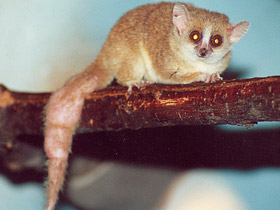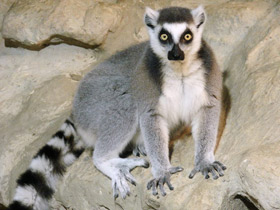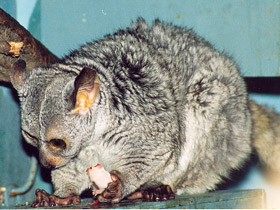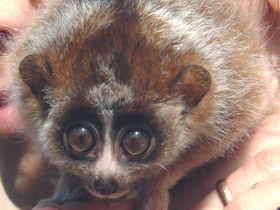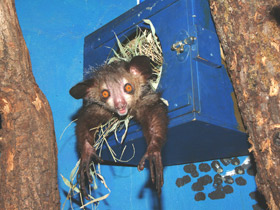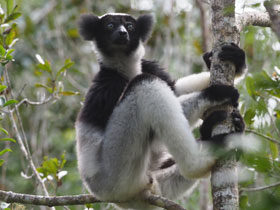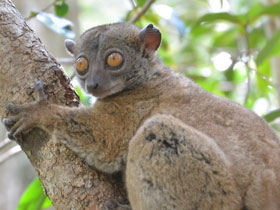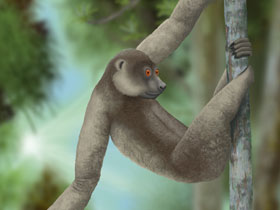The group Prosimians
Phylogenetic Tree of Prosimians
Prosimians are a group of primates that includes all living and extinct strepsirrhines (lemurs, lorisoids, and adapiforms), as well as the haplorhine tarsiers and their extinct relatives, the omomyiforms, i.e. all primates excluding the simians. They are considered to have characteristics that are more "primitive" (ancestral or plesiomorphic) than those of simians (monkeys, apes, and humans).
Simians emerged within the Prosimians as sister group of the haplorhine tarsiers, and therefore cladistically belong to this group. Simians are thus distinctly closer related to tarsiers than lemurs are. Strepsirrhines bifurcated some 20 million years earlier than the tarsier - simian bifurcation. However, simians are traditionally excluded, rendering prosimians paraphyletic. Consequently, the term "prosimian" is no longer widely used in a taxonomic sense, but is still used to illustrate the behavioral ecology of tarsiers relative to the other primates.
Prosimians are the only primates native to Madagascar, but are also found throughout Africa and in Asia.
Features of Prosimians
Perhaps not everyone knows that besides "ordinary" monkeys, there are also some "half-monkeys" living on our planet. However, this name, despite its strange sound, is quite informative and immediately brings us up to speed: it is clear that these animals are similar to monkeys, but at the same time - as if they are not quite monkeys. Prosimians are a rather vast group of animals, uniting about 50 species of amazing creatures that do not resemble each other at all. These are touching eye lories, and jumping long-tailed galago, and large bright-red lemurs varie, and tiny mouse lemurs. Scientists believe that half apes are older than the higher apes, and as we already know, the ancestors of primates were insect-eating animals. It is logical to assume that it is in modern half-monkeys could retain some primitive features of the structure characteristic of their insect-eating ancestors. And this is indeed the case. Almost all lower primates are small or medium-sized animals (like insect-eaters). The largest half-monkey, the indri, reaches a length of only 70 cm and weighs about 6 kg. The closeness of these detachments is also evidenced by the specific diet of the lower apes, largely consisting of insects. Even the teeth of the half apes resemble the teeth of more primitive insect-eaters: there are a lot of them, they are small, sharp and almost identical. It is true that some half-monkeys have incisors and fangs on the lower jaw forming a forward projecting "comb", with which the animals scrape gum (resin) from tree trunks, as well as groom their fur. Surprisingly, they also have a special protrusion under the tongue with a serrated edge, which serves for cleaning this "comb". By the way, on the second toe of the foot of half-monkeys has a claw, also used for combing the hair.
Appearance and behaviour
The appearance of most Prosimians is so different from the usual "image of an ape" that most likely we would not recognise them as relatives at all. When describing the higher apes (especially, of course, the great apes), it is even kind of awkward to use the word "muzzle". They are so similar to humans that you would rather say: "face". But in many semi- apes, the facial part of the skull is strongly protruding forward, forming an elongated muzzle, which also has special hairs - vibrissae, which play the role of organs of touch and smell (higher apes lost them in the process of evolution). The point is that in Prosimians vision does not yet play the most important role, which it will acquire in higher primates, for them olfaction and touch are much more important, and the long snout is associated with the development of these senses. This is largely due to the fact that most of the half apes lead a nocturnal or crepuscular lifestyle. Their facial expressions are poor, and unlike higher primates, Prosimians communicate with each other mainly by means of special odour tags. They have specific glands that secrete odourous substances, which the half apes apply to surrounding objects and on their own bodies. On the level of development of intelligence lower primates are much inferior to the higher and resemble rather insect-eaters: their brain is small and few crinkles in it. Their forelimbs are not yet called hands - they are not capable of fine manipulation of objects, which is so characteristic of higher primates, and along with nails they have claws. Reproduction in Prosimians is usually timed to a particular season. Their cubs (as well as all primates) are born defenseless, often naked and blind, but unlike "real" monkeys, they usually have 2 or 3 (instead of 1), and they mature for independent life much faster.
Distribution
Prosimians live in Africa, South and Southeast Asia, but they are particularly well represented on the island of Madagascar. In conclusion, it must be recognised that virtually all species of semiparasitic monkeys are rare or threatened with extinction.
Classification
The prosimians were once a group considered a suborder of the primate order (suborder Prosimii - Gr. pro, before, + Latin simius/simia, ape), which was named in 1811 by Johann Karl Wilhelm Illiger. They have been shown, however, to be paraphyletic - that is, their most recent common ancestor was a prosimian but it has some non-prosimian descendants (i.e. monkeys and apes). This relationship is shown by the ranks (prosimians in bold) in the list below of the current primate classification between the order and infraorder level. The term "prosimian" is considered taxonomically obsolete, although it is used to emphasize similarities between strepsirrhines, tarsiers, and the early primates.
Order Primates
- Suborder Strepsirrhini: non-tarsier prosimians:
- Infraorder †Adapiformes: extinct "lemur-like" primates;
- Infraorder Lemuriformes: lemurs, lorises, and bushbabies;
- Suborder Haplorrhini: tarsiers, monkeys and apes:
- Infraorder †Omomyiformes: extinct "tarsier-like" primates;
- Infraorder Tarsiiformes: tarsiers;
- Infraorder Simiiformes: New World monkeys, Old World monkeys, apes, and humans.

















